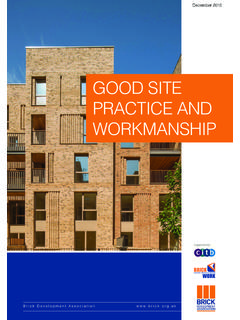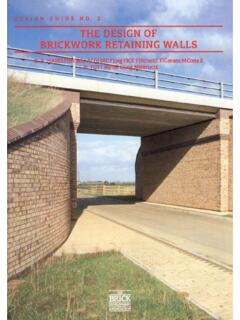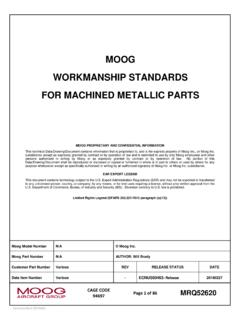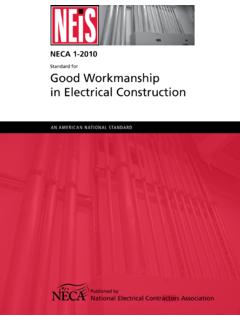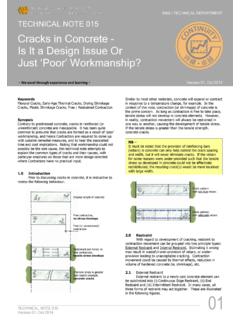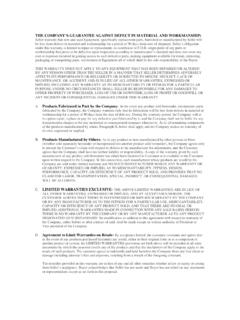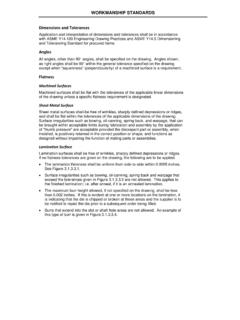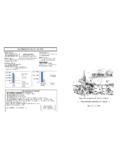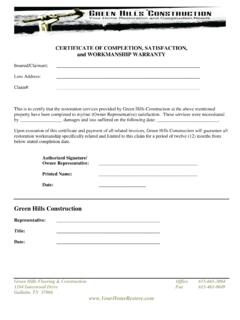Transcription of GOOD SITE PRACTICE AND WORKMANSHIP - Brick
1 December 2015. good site . PRACTICE AND. WORKMANSHIP . Brick Development Association good site PRACTICE AND WORKMANSHIP 2. Contents Page INTRODUCTION 3. ORDERING BRICKS 3. site REFERENCE PANEL 4. DELIVERY AND STORAGE 5. HANDLING AND BLENDING 6. SETTING OUT AND SIZE TOLERANCES 7. MORTAR JOINTS 8. NOTES ON BRICKLAYING 9-11. PROTECTION OF BRICKWORK 12-13. CHECK LIST 14. good site PRACTICE AND WORKMANSHIP 3. INTRODUCTION. The standard of site PRACTICE and WORKMANSHIP in the course of construction will have the greatest influence upon the quality of the finished brickwork. Bricks, mortar and other ancillary components such as lintels, ties and cavity trays must be designed and specified in accordance with all relevant codes and best PRACTICE . High levels of WORKMANSHIP and site PRACTICE should result in durable brickwork of a natural and consistent appearance requiring little or no maintenance within its design life.
2 This document sets out to assist all members of the building team including, site supervisors and bricklayers by providing guidance on good site PRACTICE and WORKMANSHIP relating to brickwork operations. Brick manufacturers have a vested interest in the achievement of successful brickwork and are able to help and offer advice on all aspects of WORKMANSHIP and site PRACTICE . References BS EN 771-1: Specification for masonry units PAS 70 Guide to appearance and site measured dimensions and tolerance BS 8000-3 WORKMANSHIP on building sites PD 6697 Recommendations for the design of masonry structures. NHBC Standards ORDERING BRICKS. l Consult with the Brick manufacturer at the earliest convenience and preferably involve them in appropriate pre-contract meetings and discussions. l Fluctuations in market demand can affect the availability of certain Brick types. l An accurate delivery schedule with the bulk order is necessary in helping the Brick supplier plan availability and delivery.
3 L Special shape bricks are commonly made as bespoke items and often subject to lead times. Early consultation with the Brick manufacturer is imperative to avoid any inconvenient impact on the contract programme. Brick Development Association good site PRACTICE AND WORKMANSHIP 4. site REFERENCE PANELS. Brickwork reference panels are important and necessary. They provide the opportunity to identify and appreciate the inherent characteristics of the Brick type specified such as colour, shape, size and texture. They will demonstrate and set the general standard of WORKMANSHIP and appearance that can be reasonably achieved by the bricklayer from the materials specified. site reference panels provide an essential benchmark should any issues arise during the brickwork programme. l site reference panels should always be constructed 1. with the involvement of the Brick manufacturer.
4 L Construct on a solid level base, where the panel can be viewed from a distance of 3 metres in natural daylight and in a location where it will remain undamaged and protected during the duration of the contract. l Construct the panel so that not less than 1m2 of Brick faces are exposed. l The bricks must be supplied by the manufacturer as a representative sample and not be subject to any further selection on site . l The panel should be constructed to a standard that can be maintained by the bricklayers for the duration of the contract. l Construct to the chosen Brick bond and incorporate the specified mortar, joint profile and colour. Special shapes and other relevant features may also be incorporated. 2. 3. l Judgement and acceptance of the panel should take place from a distance of 3m when the mortar has dried and in the presence of all appropriate parties which must include the Brick manufacturer.
5 Note: The above guidance reflects Publicly Available Specification PAS 70. and brickwork supervisors should make reference to this document. 3. Brick Development Association good site PRACTICE AND WORKMANSHIP 5. DELIVERY AND STORAGE. l Consider the access arrangements and ensure that the delivery vehicle can be safely manoeuvred to the desired point of delivery. l Provide a firm, level, clean and well drained base to allow safe delivery and storage. This area should not be at risk of soiling from passing vehicles or other adjacent site operations. l Check that the consignment is the correct type and quantity. A number of bricks should be randomly selected from the delivery to ensure that their appearance is reasonably consistent with the site reference panel. l Fired clay is hard and durable but can be susceptible to chipping so care should always be taken to place the packs carefully with the forklift and avoid allowing any distortion of the pack shape to occur.
6 Some products are not suitable for lifting by a grab, consult the manufacturer. l Bricks must be kept covered in storage and protected from inclement weather. Excessively wet or saturated bricks are difficult to lay and can give rise to the risk of efflorescence, lime leaching and mortar staining. 3 4. 7 3. Brick Development Association good site PRACTICE AND WORKMANSHIP 6. HANDLING AND BLENDING. l Care should be taken during handling to avoid chipping and damage. Once the bricks are stacked at the point of use they should be protected from the elements whilst bricklaying is not in progress. l Packs should only be opened with sharp band cutting tools. Use of a lump hammer and bolster to break the bands should be avoided as this gives rise to chipping, breakages and potential collapse of the pack. l To avoid colour banding or patches within the finished brickwork it is important to ensure that bricks are well blended.
7 Bricks should be blended from a minimum of 3 packs concurrently with some overlap between the deliveries where possible. l Each manufacturer will have factory specific opening instructions for optimum blending refer to manufacturer's recommendations. l Where circumstances allow it will be beneficial to take receipt of as many bricks as possible at an early stage to maximise colour consistency throughout the project. BELOW: Correct blending from 3 BELOW: Poor blending of bricks packs or more concurrently as the can result in unsightly banding or work proceeds. demarcation lines. 5 6 7. 3 3 7. Due to the nature of fired clay one of the characteristics that can be inherent is variation in colour shade. To avoid colour banding or patches within the finished brickwork it is important to ensure that bricks are well blended. Although as much practical blending as possible will be employed at the Brick factory, there is no substitute for blending on site .
8 Bricks should be blended from a minimum of 3 packs concurrently with some overlap between the deliveries where possible. Refer to the manufacturer for any individual product enquiry. Where circumstances allow it will be beneficial to take receipt of as many bricks as possible at an early stage to maximise colour consistency throughout the project. Care should be taken during handling to avoid chipping and damage. Once the bricks are stacked at the point of use they should be protected from the elements whilst bricklaying is not in progress. Brick Development Association good site PRACTICE AND WORKMANSHIP 7. SETTING OUT / SIZE TOLERANCE. l Bricks are manufactured to declared dimensional tolerances which acknowledge and take into account the characteristics of both the raw material and the manufacturing process. Table 1 below sets out these declared dimensional tolerances.
9 Table 1. DIMENSIONAL TOLERANCE T1. LENGTH WIDTH HEIGHT. 209mm to 221mm 98mm to 107mm 62mm to 68mm DIMENSIONAL TOLERANCE T2. LENGTH WIDTH HEIGHT. 211mm to 219mm 100mm to 105mm 63mm to 67mm Note: for 215 x 102 x 65mm only. l Before bricklaying commences it is advisable to set out a course of bricks dry in the required bond pattern. This dry course should be laid out to brickwork co-ordinating size and take consideration of openings. l Time taken to set out the brickwork appropriately at this stage will help to avoid setting out errors as work proceeds. l The setting out of general brickwork should normally be to the co-ordinating sizes of 225mm for length and 75mm for height with any tolerance within the bricks being accommodated within the mortar joints as evenly as practical, see Table 2 below. Table 2. NUMBER CO. CO + JOINT (CO-ORDINATING Co-ordinating size used for OF BRICKS SIZE) CO - JOINT.
10 1/2. design and setting out Co-ordinating Size Used for design and setting out 1 235 225 215. 11/2 2 460 450 440. 21/2 Work Size 3 685 675 665 Co-ordinating size less nominal 10mm mortar joint 31/2 4 910 900 890. 41/2 5 1135 1125 1115. Actual Size 51/2 As measured on site 6 1360 1350 1340. 61/2 7 1585 1575 1565. 71/2 8 1810 1800 1790. 81/2 9 2035 2025 2015. 91/2 10 2260 2250 2240. Brick Development Association good site PRACTICE AND WORKMANSHIP 8. MORTAR JOINTS. l Mortar specification must be appropriate for its intended use. l It is common PRACTICE for mortar to be provided pre-mixed or dispensed from a calibrated mortar silo on site . The mortar supplier's recommendations should be adhered to. l site mixed mortar should be batched consistently and accurately using batching boxes or buckets. The use of shovels for proportioning should not be used. l Bricklaying mortars should always be consistent and workable.
